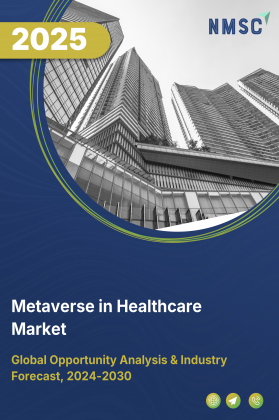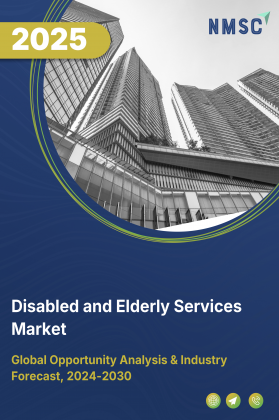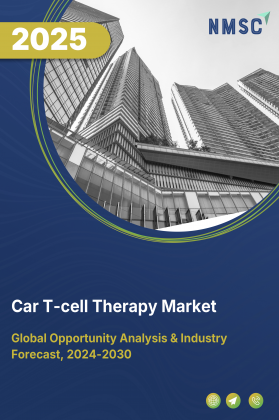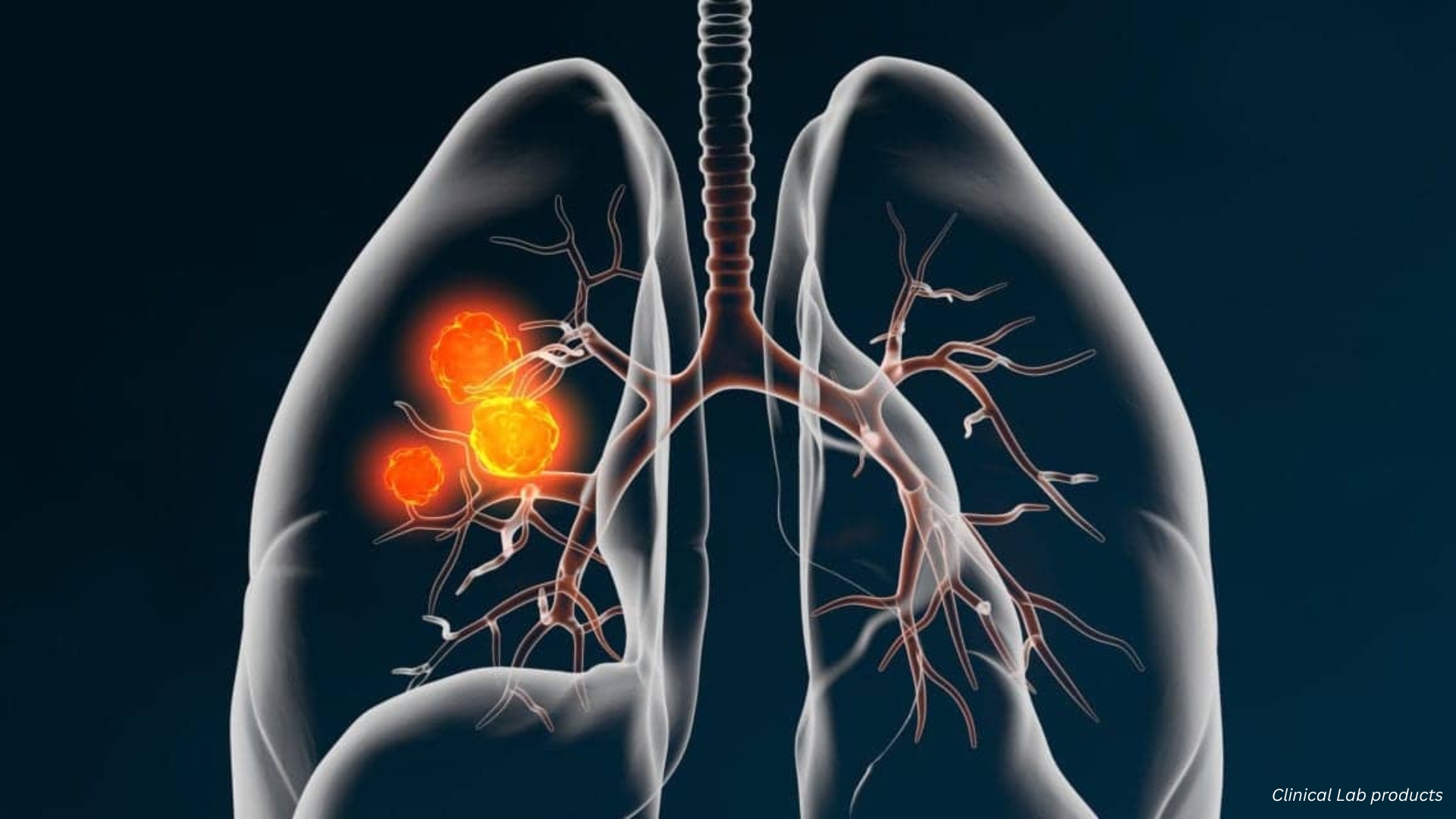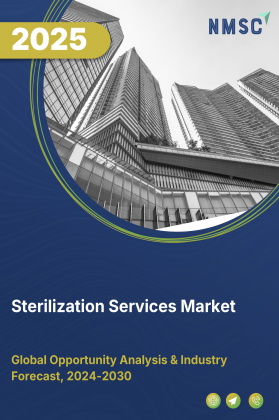
Sterilization Services Market by Method (Gas Modalities, Radiation Modalities, Steam/Heat Sterilization, Hydrogen Peroxide Sterilization, Others), by Service Type (Contract Sterilization Services, Sterilization Validation & Testing Services), by Mode of Delivery (Off-site Sterilization, On-site Sterilization), and by End User (Hospitals & Clinics, Pharmaceutical & Biotechnology Companies, Cosmetics & Personal Care Industry, Other) – Global Opportunity Analysis and Industry Forecast, 2025–2030.
Sterilization Services Industry Outlook
The global Sterilization Services Market size was valued at USD 5.91 billion in 2024, with an estimation of USD 6.44 billion in 2025 and is predicted to reach USD 9.91 billion by 2030 with a CAGR of 9.0% from 2025-2030.
The market is experiencing strong growth, driven by the rising focus on infection prevention, expanding pharmaceutical and biotechnology sectors, and increasing adoption in the food and beverage industry. The growing threat of hospital-acquired infections and the need for sterile healthcare environments are fuelling demand across hospitals, laboratories, and clinics.
At the same time, stringent food safety regulations and the surge in processed and convenience food consumption are boosting adoption in food production. In pharmaceuticals and biotechnology, rising vaccine and biologics manufacturing further accelerates the sterilization services market expansion.
However, high operational costs and capital-intensive requirements pose challenges. Despite this, advancements in sterilization technologies and service capacity are creating significant opportunities for the sterilization services market growth.
Rising Focus on Infection Prevention Boost the Market Growth
The escalating risk of hospital-acquired infections has placed infection prevention at the forefront of global healthcare priorities. Ensuring sterile environments across hospitals, diagnostic laboratories, and clinics is now critical to safeguarding patient safety and minimizing infection risks. This has significantly increased reliance on sterilization services.
Moreover, the growing burden of infectious diseases further amplifies this demand. For example, global HIV/AIDS-related deaths, which were 2.8 million in 2002, are projected to rise to 6.5 million by 2030 under a baseline scenario. Even with stronger prevention efforts, deaths could still reach 3.7 million, underscoring the urgent need for robust infection control strategies and dependable sterilization practices.
Rising Adoption of Sterilization services in the Food and Beverage Industry Leads to Market Expansion
The growing emphasis on food safety and quality assurance has increased the demand for sterilization services in the food and beverage sector. Manufacturers are under strict regulatory pressure to prevent microbial contamination and ensure longer shelf life of products.
Sterilization techniques are widely used for processing equipment, packaging materials, and storage containers, particularly in dairy, meat, beverages, and ready-to-eat products. This not only helps prevent spoilage but also strengthens consumer trust in packaged food safety. With the rising consumption of processed and convenience foods, the role of sterilization services in meeting global food safety standards continues to expand.
Expansion of the Pharmaceutical and Biotechnology Sectors Fuels the Market Demand
The growing production of vaccines, biologics, and advanced therapeutics is driving substantial demand for sterilization services in drug manufacturing and packaging. These services are essential for ensuring product safety, preventing contamination, and meeting stringent regulatory standards, making them indispensable for pharmaceutical and biotechnology companies.
For instance, the Indian pharmaceutical industry is projected to reach US$130 billion by 2030 and expand further to US$450 billion by 2047, highlighting the scale of growth in drug manufacturing and the corresponding need for reliable sterilization solutions across the sector.
High Operational Costs and Capital Investment Restrain the Market Growth
The sterilization services market faces challenges from the high operational and capital costs associated with advanced sterilization technologies such as gamma irradiation, ethylene oxide, and autoclaving. Setting up and maintaining sterilization facilities requires substantial investment in specialized equipment, skilled personnel, and regulatory compliance measures. These high costs limit adoption among small and medium-sized healthcare providers, food processing units, and pharmaceutical manufacturers, slowing market growth in certain regions.
Expansion Through Advanced Sterilization Technologies and Service Capacity Creates Future Opportunities for the Market
The market presents significant growth opportunities as companies expand capabilities and adopt advanced technologies. Recent developments, such as Life Science Outsourcing (LSO) doubling its ethylene oxide sterilization capacity and Noxilizer introducing NO₂ contract sterilization for pharmaceutical products, demonstrate the increasing demand for faster, more efficient, and specialized sterilization services.
As the industry continues to innovate, companies that invest in cutting-edge technologies and scalable service infrastructure will be better positioned to meet evolving regulatory requirements and capture new market segments. This trend underscores the long-term potential for sustained growth and global market expansion.
Market Segmentation and Scope of Study
The sterilization services market report is segmented by method, service type, mode of delivery, end user, and region. By method, it includes gas-based modalities, radiation-based modalities along with steam/heat sterilization, hydrogen peroxide sterilization, and other advanced methods. By service type, the market is divided into contract sterilization services and sterilization validation & testing services. By mode of delivery, it covers off-site sterilization through centralized facilities as well as on-site sterilization at customer premises. By end user, the market serves hospitals and clinics, pharmaceutical and biotechnology companies, food and beverage manufacturers, cosmetics and personal care industries, and other sectors such as research laboratories and electronics. Regionally, the analysis spans North America, Europe, Asia-Pacific, and Rest of the World (RoW).
Geographical Analysis
North America dominates the sterilization services market share and is expected to maintain its leadership throughout the forecast period. The region’s strong pharmaceutical and biotechnology industries, along with extensive research and development activities, drive continuous demand for advanced sterilization solutions. Growing production of biologics, vaccines, and medical devices has further accelerated the adoption of specialized and contract sterilization services, supporting market growth.
Europe is driven by stringent regulatory requirements and an emphasis on patient safety and quality standards in healthcare and pharmaceutical manufacturing. The region’s well-established medical device and pharmaceutical industries are increasingly adopting innovative sterilization technologies, such as vaporized hydrogen peroxide and NO₂ sterilization, to ensure compliance and efficiency. The ageing population and the rising demand for biologics and specialized medical treatments continue to strengthen the market outlook.
Asia-Pacific is projected to be the fastest-growing region in the market. Rapid expansion in pharmaceutical production, rising healthcare expenditure, and demographic shifts, including an ageing population, are driving demand for advanced sterilization technologies. In India, for instance, the decadal growth rate of the elderly population is estimated at 41%, and according to the United Nations Population Fund (UNFPA) 2023 India Ageing Report, the elderly population is expected to double to over 20% of the total population by 2050.
By 2046, India’s elderly population is also projected to surpass its child population (aged 0–15 years). This demographic trend, combined with increasing focus on regulatory compliance and quality standards across emerging economies, is creating opportunities for service providers to expand capacity and introduce scalable, technology-driven sterilization solutions.
The Rest of the World (RoW) is emerging as a significant growth region in the market, driven by diverse healthcare and pharmaceutical needs. In Latin America, high rates of infectious diseases and increasing pharmaceutical production are boosting demand for reliable sterilization solutions. The Middle East is advancing healthcare infrastructure and adopting innovative sterilization technologies to address rising regulatory requirements and improve public health outcomes.
In Africa, widespread bacterial infections, limited access to advanced antibiotics, and the need for cost-effective medical solutions are driving interest in specialized sterilization services. Collectively, these factors are creating substantial opportunities for service providers to expand regional capacity, introduce scalable technologies, and meet growing demand for safe and compliant sterilization solutions.
Strategic Innovations Adopted by Key Players
Key players in the sterilization services industry are expanding their operational capabilities and optimizing efficiency through strategic investments and restructuring.
-
In May 2025, Sterigenics, under Sotera Health, announced a new X-Ray sterilization facility in Haw River, North Carolina. This complemented its existing gamma network and enhanced processing capacity in the U.S. Southeast.
-
In May 2024, STERIS announced a plan to lay off fewer than 300 employees. This moves supported facility consolidation and aimed to save around USD 25 million annually by fiscal 2026, as part of a broader strategic reorganization.
Key Benefits
-
The report provides quantitative analysis and estimations of the sector from 2025 to 2030, that assists in identifying the prevailing market opportunities.
-
The study comprises a deep-dive analysis of the current and future sterilization services market trends to depict prevalent investment pockets in the industry.
-
Information related to key drivers, restraints, and opportunities and their impact on the market is provided in the report.
-
Competitive analysis of the players, along with their market share is provided in the report.
-
SWOT analysis and Porters Five Forces model is elaborated in the study.
-
Value chain analysis in the market study provides a clear picture of roles of stakeholders
Sterilization Services Market Key Segments
By Method
-
Gas Modalities
-
Ethylene Oxide
-
Other gaseous methods
-
-
Radiation Modalities
-
Gamma
-
Electron Beam
-
X-ray
-
Other radiation methods
-
-
Steam / Heat Sterilization
-
Hydrogen Peroxide Sterilization
-
Others
By Service Type
-
Contract Sterilization Services
-
Sterilization Validation & Testing Services
By Mode of Delivery
-
Off-site Sterilization
-
On-site Sterilization
By End-User
-
Hospitals & Clinics
-
Pharmaceutical & Biotechnology Companies
-
Food & Beverage Industry
-
Cosmetics & Personal Care Industry
-
Other Industries
By Region
-
North America
-
The U.S
-
Canada
-
Mexico
-
-
Europe
-
The UK
-
Germany
-
France
-
Italy
-
Spain
-
Denmark
-
Netherlands
-
Finland
-
Sweden
-
Norway
-
Russia
-
Rest of Europe
-
-
Asia-Pacific
-
China
-
Japan
-
India
-
South Korea
-
Australia
-
Indonesia
-
Singapore
-
Taiwan
-
Thailand
-
Rest of Asia-Pacific
-
-
Rest of the World
-
Latin America
-
Middle East
-
Africa
-
Key Players
-
STERIS
-
Sotera Health company
-
Ecolab Inc.
-
Belimed AG
-
SteriPackGroup.com
-
Crosstex International, Inc.
-
Medistri SA
-
infinity laboratories
-
Prince Sterilization Services, LLC
-
Pro-Tech Design and Manufacturing Inc.
-
Taisei Kako Co.,Ltd.
-
Microtrol Sterilisation Services Pvt Ltd.
-
Andersen Sterilizers
Report Scope And Segmentation
|
Parameters |
Details |
|
Market Size in 2025 |
USD 6.44 Billion |
|
Revenue Forecast in 2030 |
USD 9.91 Billion |
|
Growth Rate |
CAGR of 9.0% from 2025 to 2030 |
|
Analysis Period |
2024–2030 |
|
Base Year Considered |
2024 |
|
Forecast Period |
2025–2030 |
|
Market Size Estimation |
Billion (USD) |
|
Growth Factors |
|
|
Countries Covered |
28 |
|
Companies Profiled |
15 |
|
Market Share |
Available for 10 companies |
|
Customization Scope |
Free customization (equivalent to up to 80 working hours of analysts) after purchase. Addition or alteration to country, regional, and segment scope. |
|
Pricing and Purchase Options |
Avail customized purchase options to meet your exact research needs. |

















 Speak to Our Analyst
Speak to Our Analyst



